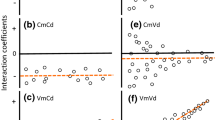Abstract
Growth of spring barley stands was followed in various conditions. Disposition of the seeds parameters the morphogenetic programme of each individual plant, which will afterwards form the stricture of the young plant stand. Later, individual stopping of tillering is controlled by this stricture. In return, the distribution of these events conditions the structure of the canopy during the shoot lengthening period. In sparse or patchy canopies, weak tillers in stopping of growth are able to survive temporarily.
The plant is not reducible to the genotype of its variety. Individual whole plant and plant stand are true organization levels in an ecosystem. It is essential to take their relationships into account throughout the growth for understanding the behaviour of a crop.
Similar content being viewed by others
References
Ballare C.L., Sanchez R.A., Scopel A.L., Casal J.J. and Ghersa C.M. (1987). Early detection of neighbour plants by phytochrome perception of spectral changes in reflected sunlight. Plant, Cell and Environment 10: 551–557.
Charles-Edwards D.A., Stutzel H., Ferraris R. and Beech D.F. (1987). An analysis of spatial variation in the nitrogen content of leaves from different horizons within a canopy.- Annals of Botany 60: 421–426.
Dale J.E. and Wilson R.G. (1978). A comparison of leaf and ear development in barley cultivars as affected by nitogen supply.- J. Agric. Sci. (Camb.) 90: 503–508.
Deitzer G.F., Hayes R. and Jabben M. (1979). Kinetics and time dependence of the effect of far red light on the photoperiodic induction of flowering in “Wintex” barley.- Plant Physiol. 64: 1015–1021.
Fairey D.T., Hunt L.A. and Stoskopf N.C. (1975). Day length influence on reproductive development and tillering in “Fergus” barley.- Can. J. Bot. 53: 2770–2775.
Gbongué D. (1985). Influence de Falimentation azotée sur l'élaboration du nombre de grains d'un peuplement d'orge d'hiver”.- Doct.ing. Thesis, Paris, INAPG, 266p.
Hilton J.R. (1983). The influence of phytochrome photoequilibrium on gibberellin-like substances and chlorophyll content of chloroplasts of Hordeum vulgare L.- New Phytol. 95: 545–548.
Kirby E.J.M. and Faris D.G. (1970). Plant population induced growth correlations in the barley plant main shoot and possible hormonal mechanisms.- J. Exp. Bot. 21: 787–798.
Kirby E.J.M., Appleyard M. and Fellowes G. (1985). Effect of sowing date and variety on main shoot leaf emergence and number of leaves of barley and wheat.- Agronomic. 5: 117–126.
Klepper B., Belford R.K. and Rickman R.W. (1984). Root and shoot development in winter wheat.- Agron. J. 76: 117–122.
Lafarge M. (1990). The dynamic of the plant population, organizing concept of relationships between a crop and its environment. Proc. 1 st congress of the European Society of Agronomy, (Paris, dec. 1990). sess. 1, post. 65.
Lafarge M. (1991a). Une démarche d'étude agronomique des climats naturels; le cas de differences d'altitude.- Agronomie 11: 369–381.
Lafarge M. (1991b). Hétérogénéité interne au peuplement et effets du milieu sur le développement des brins maîtres d'orge de printemps en altitude. 2. Précocité de montaison.- Agronomie (submitted).
Lauer J.G. and Simmons S.R. (1988). Photoassimilates partitionning by tillers and individual tiller leaves in field-grown spring barley.- Crop Sci. 28: 279–282.
Lauer J.G. and Simmons S.R. (1989). Canopy light and tiller mortality in spring barley.- Crop Sci. 29: 420–424.
Malvoisin P. (1984a). Organogénèse et croissance du maitre brin du blé tendre du semis a la floraison. 1: Relations observées entre la croissance foliaire et la différentiation des ébauches foliaires ou florales.- Agronomie 4: 557–564.
Malvoisin P. (1984b). Organogénèse et croissance du maître brin du blé tendre du semis à la floraison. 2: Contrôle des relations entre la croissance et la vascularisation de la tige et des feuilles. Essai de modélisation.- Agronomic 4: 587–596.
Masle-Meynard J. (1981). Elaboration du nombre d'épis d'un peuplement de blé d'hiver en situation de compétition pour àzote. 1: Mise en évidence d'un stade critique pour la montée d'une talle. Agronomie 1: 623–632.
Masle-Meynard J. and Sebillotte M. (1981a). Etude de l'hétérogénéité d'un peuplement de blé d'hiver. 1: Notion de structure du peuplement.- Agronomie 1: 207–216.
Masle-Meynard J. & Sebillotte M. (1981b). Etude de l'hétérogénéité d'un peuplement de blé d'hiver. 2: Origine des différentes categories d'individus du peuplement; éléments de description de sa structure.- Agronomic 1: 217–224.
Masle J. (1985). Competition among tillers in winter wheat: consequences for growth and development of the crop. In: Day & Atkin, ed. Wheat Growth and Modelling.- New York, Plenum Press, NATO ASI serie A, 86: 33–54.
Metivier J.R. and Dale J.E. (1977). The utilization of endosperm reserves during early growth of barley cultivars and the effect of time of application of nitrogen.- Ann. Bot. 41: 715–728.
Vincent A. 1986. Economie de la plante: importance de l'installation et de l'activité des racines. In: L. Gachon, ed. L'Elaboration du Rendement des Cultures Céréalières. (coll. franco-roumain,).- Paris, INRA, p.31–55.
Author information
Authors and Affiliations
Rights and permissions
About this article
Cite this article
Lafarge, M. Reciprocal conditioning between the “plant stand” level and the “ndividual whole plant” level during the formation of the ear population of a spring cereal crop. Acta Biotheor 39, 343–350 (1991). https://doi.org/10.1007/BF00114186
Published:
Issue Date:
DOI: https://doi.org/10.1007/BF00114186




